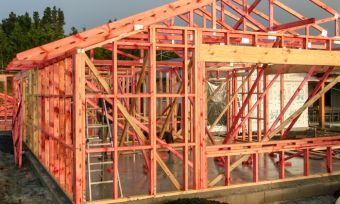Most people apply for finance to purchase a section and to build a new home at the same time. This requires two finance offers, one for each stage of the project, which means a range of different conditions need to be met. The paperwork needed can include:
- A registered valuation of the section and completed build
- A copy of the title of the section
- The build contract and plans
- Consent details
- Builders’ risk insurance
It’s worth noting that land and construction loans are currently exempt from the Reserve Bank’s loan-to-value (LVR) restrictions, which can make it easier for those with smaller deposits to fund a new build.
→ Related article: What is a Loan-to-value Ratio (LVR)?
Loan for a new build: what is a registered valuation?
All banks require a registered valuation prior to the build starting. This covers the completed value based on the build contract and specifications. While some banks require further valuations, which come with added costs during the build, others don’t, which can save you money.
Some banks calculate their LVRs using the registered valuation, instead of using the cost to complete. This is a clearer way to assess the market value of your proposed build and, against a backdrop of rising prices, possibly save you money on lenders’ mortgage insurance.
→ Related article: What is Lenders’ Mortgage Insurance?
Loan for a new build: what buffer do I need?
Home loan lenders will add up to a 15% buffer above the fixed price of your build contract to allow for budget overruns. For example, if your fixed price contract is $450,000 then it could actually be assessed at $517,500 (15% more).
This buffer can affect the level of borrowing you’re able to achieve, and might adversely affect your chances of approval.
As individual banks and lenders have different rules around new builds, arranging the best mortgage to suit your building plans and budget can be time consuming. As a result, it’s important to establish good lines of communication between your choice of builder and finance provider.
Loan for a new build: how does the loan work?
Usually, a construction loan for a new build is drawn down progressively. This means that you draw down the loan (increase your borrowing) in stages, as you pay for the progress of your new build. For example, as each stage of your home is completed, the builder will invoice you for the work done. You then submit that invoice to your lender for payment.
A construction loan usual has a variable interest rate, until the last payment on the house is made, when you renegotiate with your lender to switch to a standard mortgage.
Variable interest rates are usually a lot higher than fixed rates. So it’s important to shop around for the best deal. Over the course of an extended build period, you could save a considerable amount in interest.
Cheapest Home Loan Rates for First Home Buyers
The table below displays some of the 1-year fixed-rate home loans on our database (some may have links to lenders’ websites) that are available for first home buyers. This table is sorted by current interest rates (lowest to highest), followed by company name (alphabetical). Products shown are principal and interest home loans available for a loan amount of $500K in Auckland. Before committing to a particular home loan product, check upfront with your lender and read the applicable loan documentation to confirm whether the terms of the loan meet your needs and repayment capacity. Use Canstar’s home loan selector to view a wider range of home loan products. Canstar may earn a fee for referrals.
Compare Cheapest Home Loan Rates for First Home Buyers
About the author of this page
This report was written by Canstar’s Editor, Bruce Pitchers. Bruce has three decades’ experience as a journalist and has worked for major media companies in the UK and Australasia, including ACP, Bauer Media Group, Fairfax, Pacific Magazines, News Corp and TVNZ. Prior to Canstar, he worked as a freelancer, including for The Australian Financial Review, the NZ Financial Markets Authority, and for real estate companies on both sides of the Tasman.
Enjoy reading this article?
You can like us on Facebook and get social, or sign up to receive more news like this straight to your inbox.
By subscribing you agree to the Canstar Privacy Policy





Share this article